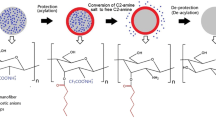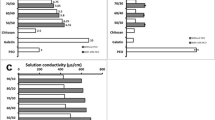Abstract
PEG-N-chitosan and PEG-N,O-chitosan were synthesized via reductive amination and acylation of chitosan, respectively. The structures were confirmed by FTIR and H1NMR. The extents of PEGylation increased with reducing chain lengths of either chitosan (M v = 137–400 kDa) or poly(ethyelene glycol) (PEG, M n = 500–2 kDa). Water solubility were easily achieved at degree of substitution (DS) as low as 0.2 for either derivtive whereas the PEG-N,O-chitosan at DS = 1.5 was soluble in organic solvents, including CHCl3, DMF, DMSO and THF. None of the aqueous solutions of PEG-N-chitosan or PEG-N,O-chitosan alone could be electrospun into fibers. Electrospinning of PEG550-N,O-chitosan145 at 25% in DMF produced fibrous structure intermixed with beads. The efficiency of fiber formation and the uniformity of fibers were improved by increasing the solution viscosity using a cosolvent or reducing the solution surface tensions with a non-ionic surfactant. Ultra-fine fibers with diameters ranging from 40 nm to 360 nm and an average diameter of 162 nm were efficiently generated from electrospinning of 15% PEG550-N,O-chitosan145 in 75/25 (v/v) THF/DMF cosolvents with 0.5% Triton X-100TM.







Similar content being viewed by others
References
Avigad GA (1983) Simple spectrophotometric determination of formaldehyde and other aldehydes: application to periodate-oxidized glycol systems. Anal Biochem 134(2):499–504
Bentley MD, Roberts MJ, Harris JM (1998) Reductive amination using poly(ethylene glycol) acetaldehyde hydrate generated in situ: Applications to chitosan and lysozyme. J Pharmaceutical Sci 87(11):1446–1449
Bhattarai N, Edmondson D, Veiseh O, Matsen FA, Zhang MQ (2005a) Electrospun chitosan-based nanofibers and their cellular compatibility. Biomaterials 26:6176–6184
Bhattarai N, Ramay HR, Gunn J, Matsen FA, Zhang MQ (2005b) PEG-grafted chitosan as an injectable thermosensitive hydrogel for sustained protein release. J Control Release 103:609–624
Binias D, Boryniec S, Binias W (2005) Studies of the structure of polysaccharides in the process of alkaline treatment of dibutyrylchitin fibres. Fibres Text East Eur 13(5):137–140
Anjali Devi D, Smitha B, Sridhar S, Aminabhavi TM (2006) Novel crosslinked chitosan /poly(vinylpyrrolidone) blend membranes for dehydrating tetrahydrofuran by the pervaporation technique. J Membr Sci 280:45–53
Duan B, Dong C, Yuan X, Yao K (2004) Electrospinning of chitosan solutions in acetic acid with poly(ethylene oxide). J Biomater Sci Polym Ed 15:797–811
Geng X, Kwon OH, Jang J (2005) Electrospinning of chitosan dissolved in concentrated acetic acid solution. Biomaterials 26:5427–5432
Gorochovceva N, Makuška R (2004) Synthesis and study of water-soluble chitosan-O-poly (ethylene glycol) graft copolymers. Eur Polym J 40:685–691
Gorochovceva N, Naderi A, Dedinaite A, Makuska R (2005) Chitosan-N-poly(ethylene glycol) brush copolymers: Synthesis and adsorption on silica surface. Eur Polym J 41:2653–2662
Guo TY, Xia YQ, Wang J, Song MD, Zhang BH (2005) Chitosan beads as molecularly imprinted polymer matrix for selective separation of proteins. Biomaterials 26:5737–5745
Harris JM (1992) Poly (ethylene glycol) chemistry: biotechnical and biomedical applications. Plenum Press, New York
Jayakumar R, Prabaharan M, Reis RL, Mano JF (2005) Graft copolymerized chitosan–present status and applications. Carbohyd Polym 62:142–158
Li L, Hsieh YL (2006) Chitosan bicomponent nanofibers and nanoporous fibers. Carbohyd Research 341:374–381
Nishimura S, Kohgo O, Kurita K, Kuzuhara H (1991) Chemospecific manipulations of a rigid polysaccharide: syntheses of novel chitosan derivatives with excellent solubility in common organic solvents by regioselective chemical modifications. Macromolecules 24:4745–4748
Ohkawa K, Cha D, Kim H, Nishida A, Yamamoto H (2004) Electrospinning of Chitosan. Macromol Rapid Commun 25:1600–1605
Ouchi T, Nishizawa H, Ohya Y (1998) Aggregation phenomenon of PEG-grafted chitosan in aqueous solution. Polymer 39:5171–5175
Park WH, Jeong L, Yoo DI, Hudson S (2004) Effect of chitosan on morphology and conformation of electrospun silk fibroin nanofibers. Polymer 45:7151–7157
Roberts GAF, Domszy JG (1982) Determination of the viscometric constants for chitosan. Int J Biol Macromol 4:374–377
Shawon J, Sung C (2004) Electrospinning of polycarbonate nanofibers with solvent mixtures THF and DMF. J Mater Sci 39:4605–4613
Spasova M, Manolova N, Paneva D, Rashkov I (2004) Preparation of chitosan-containing nanofibres by electrospinning of chitosan/poly(ethylene oxide) blend solutions. e-Polymers 056:1–12
Sugimoto M, Morimoto M, Sashiwa H, Saimoto H, Shigemasa Y (1998) Preparation and characterization of water-soluble chitin and chitosan derivatives. Carbohyd Polym 36:49–59
Tirelli N, Lutolf MP, Napoli A, Hubbell JA (2002) Poly (ethylene glycol) block copolymers. Rev Mol Biotechnol 90:3–15
Wang SC, Wei TC, Chen WB, Tsao HK (2004) Effects of surfactant micelles on viscosity and conductivity of poly(ethylene glycol) solutions. The J Chem Phys 120:4980–4988
Author information
Authors and Affiliations
Corresponding author
Rights and permissions
About this article
Cite this article
Du, J., Hsieh, YL. PEGylation of chitosan for improved solubility and fiber formation via electrospinning. Cellulose 14, 543–552 (2007). https://doi.org/10.1007/s10570-007-9122-3
Received:
Accepted:
Published:
Issue Date:
DOI: https://doi.org/10.1007/s10570-007-9122-3




